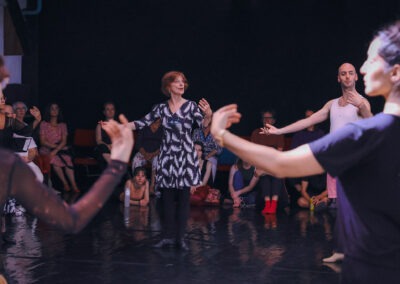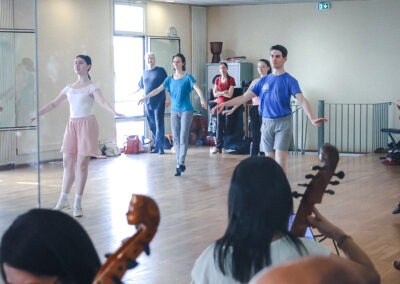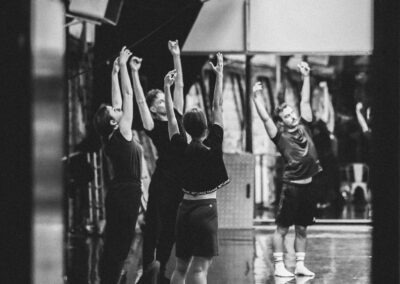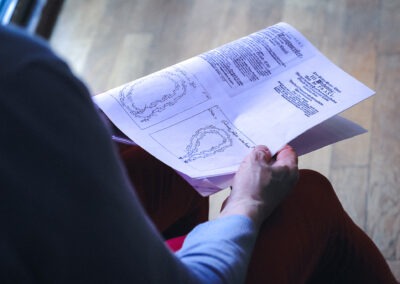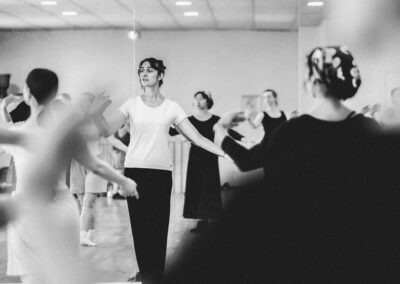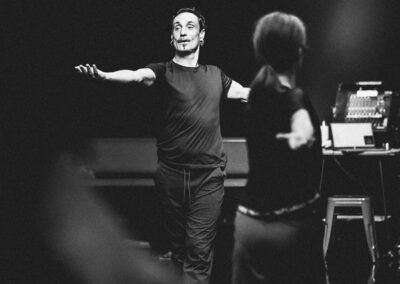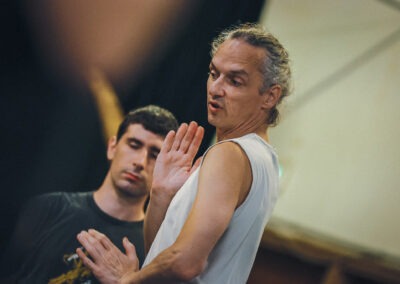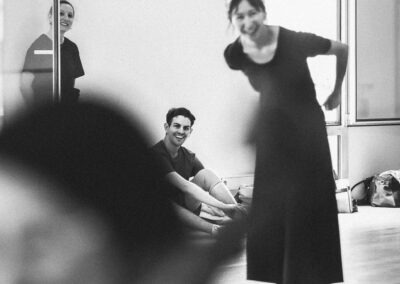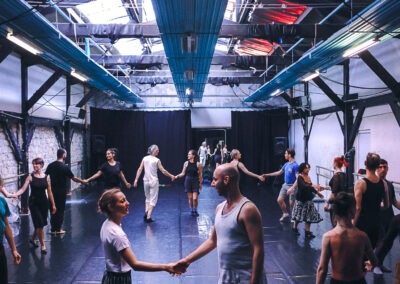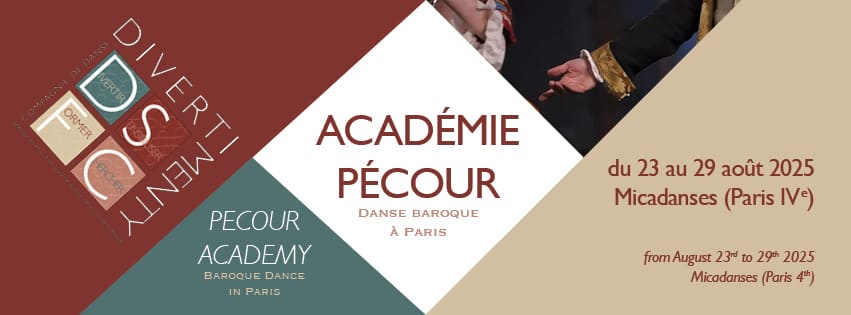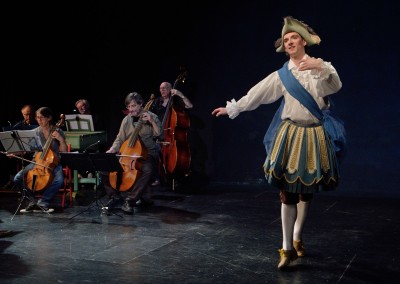PECOUR ACADEMY – BAROQUE DANCE IN PARIS – 3rd EDITION IN 2025
This Baroque dance academy offers in-depth work on the technical sources, the repertoires and the challenges of putting them into practice. It is aimed at an international audience by offering bilingual and intermediate-advanced to professional education. The schedule consists of morning technical classes and afternoon workshops with Irene Feste, Hubert Hazebroucq and Guillaume Jablonka.
FROM SATURDAY 22ND OF AUGUST AT 6 PM TO FRIDAY 28TH OF AUGUST 2026 AT 4 PM
THÈME: REPERTORY AND CREATION / DIVERTIMENTY CELEBRATES ITS 20TH ANNIVERSARY
IN 2026, MEETING WITH MARIE-GENEVIÈVE MASSÉ: discussion around video archives of her experience as a performer within Ris et Danceries under the direction of Francine Lancelot, and as a choreographer within the baroque dance company L’Eventail that she directed for 40 years.
Educational organization
- For the morning technical class, each teacher offers different choreographies. Participants choose only one course and take it all week. The afternoon workshops are organized in two different slots (14:15-15:30 then 15:45-17:00), each participant chooses a workshop for the first slot and another workshop for the second slot.
For each of the 3 teachers, the repertoire of the morning classes in 2025 is a choreography by A. L’Abbé on an air by J.B Lully. Click on photos to read biographies
Repertoire worked with Hubert Hazebroucq
- Loure or Faune perform’d before his Majesty King William the 3d bÿ Monsr. Balon and Mr. L’abbé, on a tune from Acis et Galatée FL/1725.1/01 LM-5260 : Consult the choreography
Content of the class with Hubert Hazebroucq
Repertoire worked with Guillaume Jablonka
- Canaries perform’d by Mr La Garde & Mr Dupré, on a tune from Isis FL/1725.1/07 LM-1700 : Consult the choreography
Content of the class with Guillaume Jablonka
Repertoire worked with Irène Feste
- Passacaille of Armide by Mrs Elford and Mrs Santlow, on a tune from Armide FL/1725.1/02 LM-6520 : Consult the choreography
Content of the class with Irène Feste
Master class with Christine Bayle : La Nouvelle Forlane
Thursday 28th August from 3:45 pm to 5:45 pm
A group of participants at the Pécour Academy 2025 will prepare La Nouvelle Forlane with Irène Feste from Sunday to Wednesday, then Christine Bayle will join this group on Thursday for a master class. The other group of participants will attend the master class for free on Thursday and all are invited to a drink of friendship in a Parisian garden at the end of the master class.
10 tickets for assisting to the master class of Christine Bayle are on sale at the price of 15 € per person by following this link: https://www.helloasso.com/associations/divertimenty/evenements/acces-auditeur-libre-ticket-for-assisting-to-master-class-christine-bayle
Afternoon workshops
Pierre Rameau’s writings, in conjunction with other publications, will be the constant throughout the afternoon.
Time slot 14:15-15:30 : The courante in the long 17th century (H. Hazebroucq) OR The dance steps : evolution and mutation (I. Feste + G. Jablonka)
Rameau’s Maître à danser is one of the last sources to describe the courante, a couple ball dance that appeared as early as the 16th century, and is emblematic of the Belle Danse. Drawing on several sources, choreographies and treatises, notably Italian, English and German, we will follow the evolution of steps, their structure and execution, as well as the forms of the duet, to identify constants and variants. We’ll also experiment with several versions for the “low arms” that constitute regular coordination for both the courante and the minuet.
2 The dance steps : evolution and mutation
Departing from a selection of dance steps, we will consider their evolution through different writings of great masters (De Lauze, Feuillet, Rameau, Magri, Despréaux,…). Putting into practice some examples from choreographies or workbooks will help us experience these mutations or continuities from one era to the next.
Time Slot 15:45-17:00 : La Nouvelle Forlane / Master-Class (I. Feste) OR Curtseying / La Blonde et La Brune / Menuet de la Reine (G. Jablonka + H. Hazebroucq)
3 La Nouvelle Forlane / Master-Class
We will be learning the original choreography of Guillaume Louis Pécour and its revised version by Pierre Rameau, notated according to his new method. Emphasis will be placed on the application of arm, body and head movements as possibly described by Pierre Rameau. This session will be punctuated by a master class with Christine Bayle.
4 Curtseying / La Blonde et La Brune / Menuet de la Reine
We will go back on the dance « révérences » before and after dancing, as taught by Pierre Rameau but also by other masters in order to note the differences and evolutions as well as how to recognize them in the notation.
The document entitled La Blonde et la Brune is written according to the choreography of the new method. Its reading will allow us to appreciate the nuances of this system. Its comparison with two other sources will place it in the major turning point of the dance of his time.
The Coursillon or Menuet de la Reine, attributed to Pécour, will give us the opportunity to work on various hypotheses for the minuet step according to Rameau, as well as on the most common ornaments of the ballroom minuet – all the while familiarizing ourselves with the notation system used for this score. A link will be made with the version of Magny dated 1765 and attributed to Marcel.
Dates and schedule
- Sa Aug.23rd 2025 6 pm : welcoming and collective dancing time
- Sun Aug 24th till Thu 28th : 10 am-6 pm technical class, workshops, talks
- Fri Aug 29th : 10 am-1 pm classes then public presentation gathering all participants at 2 pm
- Optional convivial moments : dinner on the banks of the Seine…
Training locations and access
- Micadanses, 15, 16 et 20 rue Geoffroy l’Asnier, 75004 Paris : we will train in three different studios MayB, Noces et Biped.
- Public transport access : Metro 7 Pont Marie or Metro 1 St Paul, easily accessible also over Châtelet-Les Hallesstation then a 10 minutes walk.
These studios are easily accessible by Châtelet-Les Halles, the main metro and RER exchange station, for those who would choose accommodation far from Paris and therefore cheaper.
If you have troubles finding an accomodation (prices or availability), please contact us and we will try to find a solution.
The area has supermarkets and fast food options for easy and convenient lunches. It is possible to eat outdoors to enjoy the neighborhood or indoors in case of rain.
Cost of Training
- Registration fee : 60 € obligatory to validate the registration and non-refundable
- Educational fee : 285 € for registration before May 1st 2024, otherwise 325 € for registration after this date
Accommodation and meals are the responsibility of the participants. For advice, do not hesitate to contact us.
To register
Complete the form by clicking on the button below. You will receive a response as soon as possible. Professors reserve the right to make you another proposal. If your request is accepted, the terms of payment will be specified. For candidates whom teachers do not know, please attach a CV and a link to a video where you are seen dancing.
ATTENTION : QUOTA OF 30 REGISTRATIONS REACHED, APPLICATIONS WILL NOW BE PUT ON WAITING LIST
Why this academy ?
- Baroque dance is reaching an increasingly large international audience and is gaining ground in more and more different countries. However, once at a certain level, it is often difficult for amateur and professional dancers to continue to progress due to the lack of advanced students to fill local classes. This academy proposes to gather for a week these dancers in demand of a high level work provided by quality teachers.
Why referring to Pecour ?
- Guillaume Louis Pécour was a key figure in the dance world around 1700. He succeeded Pierre Beauchamp as ballet master to the court and Opera. Both his ball dances and his ballet entrées are transcribed by Feuillet into the Chorégraphie notation system and Pierre Rameau receives from him a public approval for the content of the publication Le Maître à Danser. Pécour is the keystone of the dance building in the Baroque era. It then seems relevant as a reference for a baroque dance academy in Paris.
Why these trainers ?
- The trainers are all professionals of the Baroque world in activity and with a recognized career. They are particularly distinguished by their involvement in practical research activities around baroque dance.
Which prerequisites ?
- This academy is aimed at participants with a technical level in baroque dance from intermediate/advanced to advanced/professional.
What outfit to learn ?
- The teaching team expressly requests a pair of adapted dance shoes with wide heel. (for example Cabaret model of the brand Sansha at 28 to 35 € per pair). The rest of the outfit should be soft and comfortable but not too loose at the legs so that teachers can correct students.
What is baroque dance ?
- What is now called «baroque dance» is the result of some fifty years of research into the restitution and putting on shows of the academic dance of French origin practiced in the 17th and 18th centuries.
A lire aussi :
- Qu’est-ce que la danse baroque ?
- Les Clefs de la Culture Baroque pour mieux comprendre cette époque, sa danse, et ce qu’on en fait aujourd’hui
- Le parcours de Guillaume Jablonka, directeur artistique de Divertimenty
- Découvrez les artistes qui collaborent avec Divertimenty
- Soutenez la compagnie
- La presse : ils parlent de nous
- Ils nous ont accueilli
SHOWS BY DIVERTIMENTY
About the compagnie
Since 2006, Divertimenty has been offering live performances and actions around the dance culture of the 18th century. The creations are fortified by current theoretical and practical research to anchor the contemporary aspect of the new baroque generation that the company embodies.
Contact
contact at divertimenty.org
Choreographer
Guillaume Jablonka
+33 06.62.52.50.28
Administrative contact
Vanessa Colas
+33 06.42.87.00.62
Mentions légales
Directeur de la publication : Martine Ravaine
Réalisation : Rachel COUDRAY pour POLIPHILIA – 2014
Hébergement : OVH
Crédits photographiques : Mélanie Foucault, Christophe Perricon, Valérian, Poliphilia, Alice Bloch (Opéra comique)
SIRET : 507 739 662 00025
APE : 9001 Z
Licence d’entrepreneur du spectacle PLATESV-R-2021-013023
Organisme de formation professionnelle 11 92 17047 92



